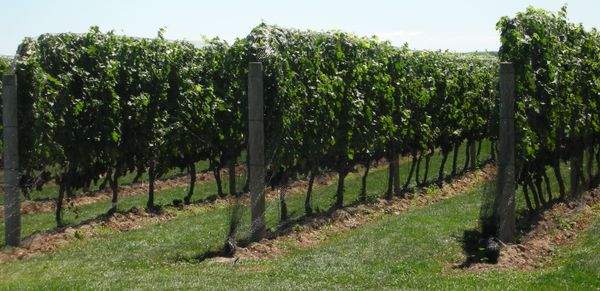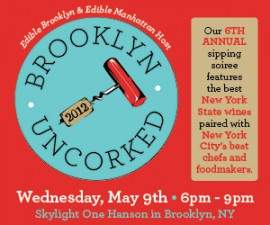Long Island’s 2009 Vintage: Quantity Down. Quality…to be Determined.
By Lenn Thompson, Founder and Editor-in-Chief
The downfall of the 2009 Long Island wine vintage has been greatly exaggerated.
Especially with regard to quality-focused producers.
Yes, 2009 has been a difficult year for grape growers on Long Island. Very difficult. So difficult in fact that David Page, co-owner of Shinn Estate Vineyards told me that “there has never been a more frustrating spring since we started growing grapes.”
A Smaller Crop
That cool, rainy spring — particularly an overcast June lowlighted by 20-plus days of rain — wreaked havoc on flowering vines and invited a condition known as coulure.
Caused by a carbohydrate deficiency an triggered by periods of cold, cloudy, wet weather, coulure (also known as 'shatter') causes flowers to stay closed and not be fertilized. Without fertilization, the vines are not pollinated. Without pollination the grapes never develop. Fewer developing berries means that grape crops are going to be much smaller across the region.
These fruit set problems have been widespread — every grower I’ve spoken to has been affected — but the percentage of crop lost varies wildly from vineyard to vineyard — and even from row to row. In some cases, grape variety mattered. In others, it was more about location.
Some growers lost as little as 2% of their overall crop, while others have lost much more, even entire blocks.
For quality-focused producers, these reduced yields aren’t necessarily a bad thing. In fact, many growers would have dropped fruit to reduce yields if Mother Nature hadn’t done it for them. According to Rich Olsen-Harbich, winemaker at Raphael in Peconic “Fruit set on most of our vineyard blocks was down by 25-30%. Bear in mind though that with a 100% fruit set we need to drop anywhere from 25-50% of our fruit during the summer anyway. We'll be right in our usual realm of 2 - 2.5 tons per acre. Those producers who were looking for more this year are going to be disappointed. But, in my honest opinion fine red wines are not made with much higher yields in this climate anyway.”
Putting it even more simply, Juan Micieli-Martinez, winemaker at Martha
Clara Vineyards told me in an email “We’ve seen a (crop) reduction of
about 45%. (But) reduced yields are a winemaker’s dream.”
But, if you typically crop to 6 or 7 tons per acre (or more), make mediocre wine, and charge low prices for them —making your money through quantity rather than quality — you're in a lot more trouble than if you are used to working (and making money) with lower yielding vineyards.
So yes, yields are down and, in some cases, very down. But that’s only the first part of the story.
Quality To Be Determined
While crop size is largely determined in the spring, the ripeness and
quality of that fruit is typically determined by the last two months of
the season — September and October. The time period that starts today.
Now that smaller crop has to ripen — a process that was slowed early on by what was one of the coolest months of July in recorded history.
Before this recent run of warm, sunny weather, growers were definitely behind schedule — up to three weeks or more — in terms of getting fruit ripe enough to make good wine. But, the recent heat wave has started to close that gap.
Page estimates that they are “behind by three-to-five days” while Miguel Martin, winemaker at Palmer Vineyards, told me over the weekend that he is “behind about a week to ten days," adding that "The weather for the next few weeks will be crucial.”
With dry, sunny, warm weather in the forecast from now well into next week, things are looking up.
Chris Tracy, winemaker at Channing Daughters Winery down on the South Fork definitely isn’t ready to write off this vintage, saying “Quality is still to be determined, but the last three weeks have been warm and dry and if the next three to five weeks are also warm and dry we could have very high quality.”
Micieli-Martinez doesn’t like to talk about being ahead or behind at all “Behind. Ahead. Behind. Ahead…we talk about this every year, but if you look at the records, historically we always pick right around the same time. I thoroughly believe we will be right around the same point as normal. The weather — everyone talks about it, but nobody does anything about it!”
Hurricanes Another Concern
This time of year, ripeness isn’t the only concern for local grape growers. Not many wine regions have to concern themselves with hurricanes, but Long Island is one of them.
“Rain and heavy winds will affect the quality of the fruit as it could cause a premature defoliation of the basal leaves,” says Martin. Without those leaves, photosynthesis slows and the fruit might not ripen fully.
Micieli-Martinez’s puts it all in perspective saying “I have family in New Orleans and have a greater understanding of what can occur with a direct hit from one of these storms. Am I concerned about potential damage? Absolutely, but we have control over so few things in the vineyard. This is no different than anything else.”
Luckily, the remnants Hurricane Danny moved out to sea last weekend, bringing a little rain, but not much else.
The Waiting Game
Growing grapes on Long Island isn’t easy, and this year has reminded anyone — as if they could forget — that Mother Nature is in charge. But, there is still plenty of time for this to be a high-quality vintage on Long Island. The next several weeks will be crucial.
Will 2009 be a good year for Long Island wine? It just too early to say, but it doesn't make sense to write off the vintage yet.
“Many, many things will happen in the coming weeks. Let’s talk about the vintage when the grapes are in and the wines have finished fermenting. Much more can be ascertained then,” says Tracy.
Until then, everyone — growers, winemakers and consumers alike — has to wait, hoping for sunny, dry weather through November.



















(According to Rich Olsen-Harbich, winemaker at Raphael in Peconic “Fruit set on most of our vineyard blocks was down by 25-30%. Bear in mind though that with a 100% fruit set we need to drop anywhere from 25-50% of our fruit during the summer anyway. We’ll be right in our usual realm of 2 - 2.5 tons per acre)
However, you don’t get to decide which clusters to cut/drop in a year like this. Which brings us back to the quality again. Does this make sense?
Suzanne,
That’s a very good and fair point and not one that can be discounted.
The fact remains though, that in some places, the vines are “used” to these lower crop loads and have ripened them in the past, with pretty solid consistency.
Perhaps Rich, who reads this blog, can respond better.
Sure. Suzanne that is a good question. The task of thinning fruit is not an exact science. In most years we strive for uniformity in the vines so we can accomplish tasks in the vineyard more easily. You’re right that we don’t get to choose all the time and this year is even more of a hodgepodge. We have some vines that could use more fruit, some that have just enough and others that have too much fruit and are in need of intense thinning. The bottom line is that we have to approach every vine indiviudally which makes it a more intelligent task this year, however we are still looking at less labor costs for thinning this year than in years where the vines are uniformly over-set. In those years it is an easier job but as every single vine has to be handled, it takes more time.
Do we get to select exactly where each cluster remains? - not really but we can come pretty close. Its important that clusters are not overlapping each other and that they have good air circulation. The quality issue is always the most important factor and that is ultimately going to be determined by the weather for the next 2 months. Quality winemaking is never about how much wine you can make but about how good you can make your wine. I’m very optimistic that the season will end well. As they say in sports - we’re due…;-)
Thanks. I wish everyone a sunny, warm September and a great harvest.
Those are some fine looking vines.